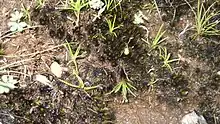Utricularia scandens
Utricularia scandens is a small, probably annual carnivorous plant that belongs to the genus Utricularia. It has a wide native distribution that includes Africa (Angola, Cameroon, the Central African Republic, Côte d'Ivoire, the Democratic Republic of the Congo, Ethiopia, Guinea, Madagascar, Malawi, Mozambique, Nigeria, South Africa, Sudan, Tanzania, Zambia, and Zimbabwe) and Asia (Bangladesh, Burma, China, India, Indonesia, Malaysia, Nepal, Sri Lanka, Thailand, and Vietnam). U. scandens grows as a terrestrial plant in wet grasslands and bogs at lower altitudes around sea level up to 2,300 m (7,546 ft). It was originally described by Ludwig Benjamin in 1847. There is a significant amount of synonymy established for this species, in part because of its large distribution and variable morphology.[1]
| Utricularia scandens | |
|---|---|
 | |
| Insectiveorus plant-rhizomatus herb, moist soil by exposed rocks, flowers yellow. | |
| Scientific classification | |
| Kingdom: | Plantae |
| Clade: | Tracheophytes |
| Clade: | Angiosperms |
| Clade: | Eudicots |
| Clade: | Asterids |
| Order: | Lamiales |
| Family: | Lentibulariaceae |
| Genus: | Utricularia |
| Subgenus: | Utricularia subg. Bivalvaria |
| Section: | Utricularia sect. Oligocista |
| Species: | U. scandens |
| Binomial name | |
| Utricularia scandens | |
Synonyms
- Polypompholyx madecassa H.Perrier
- Utricularia bifida var. wallichiana (Wight) Thwaites
- U. gibbsiae Stapf
- U. macrolepis Wight
- [U. micropetala Hutch. & Dalziel]
- [U. prehensilis Pellegr.]
- U. scandens subsp. scandens P.Taylor
- U. scandens var. scandens P.Taylor
- U. scandens subsp. schweinfurthii (Baker ex Stapf) P.Taylor
- U. schweinfurthii Baker ex Stapf
- U. wallichiana Wight
- U. wallichii Wight
- U. volubilis Wight
See also
References
- Taylor, Peter. (1989). The genus Utricularia - a taxonomic monograph. Kew Bulletin Additional Series XIV: London.